Canada’s military is facing “significant challenges” on a number of fronts which threaten its ability to fulfill its mission, an internal report by the Department of National Defence has concluded.
While those findings are not new and have been previously voiced by various stakeholders and observers, they summarize a strategic view held by the Assistant Deputy Minister (Review Services), the department’s branch in charge of providing independent reviews of the military’s policies and activities.





